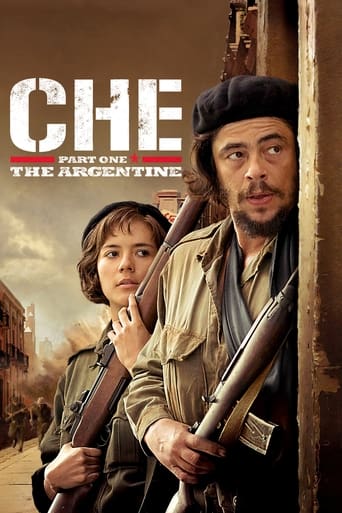

I wouldn't expect a balanced film from Steven Soderbergh, but it's worth pointing out that this and its second part present a pretty idealized picture of Che and the Cuban revolution. Guerrilla warfare by definition often treads on some morally ambiguous territory and the picture of Che that's presented really makes him out to be the "good guy" in a revolution that definitely had some shades of gray. Lots of people associated with the Batista regime somehow ended up being executed, and Che never got his hands dirty? Hard to believe. That being said, the film looks very nice and Del Toro gives a great performance as Che.
... View MoreJust what we need. A movie that glorifies a butcher and an idea that Killed over 100 million people. Why not make a movie that shows the true face of Communism? Let's show, what it brings: A high death right and a low standard of living. A much more accurate film to watch is; "Katyn". This film shows how the Soviets murdered in cold blood thousands of Polish officers. Yet, no one heralds this true movie. Che was a racist and a hater of Gays. How many more movies do we need about this murderer? How does that wash in Hollywood? Why not make a movie about Heinrich Himmler and show his human side? Why do movie makers love Communism so much? They should go and live in North Korea or Cuba. What dribble!
... View MoreThis movie follows the beginning of the relationship between Ernesto "Che" Guevara and Fidel Castro as they head to Cuba to begin the revolution. Finding the history of this relationship fascinating, I had very high hopes for the film. Unfortunately it did not meet my expectations. Though I felt that the movie was accurate historically the presentation was lacking. The acting in Soderbergh's Che: The Argentine (Part One) is stilted at best and often feels very forced, especially whenever Che has one of his many (very many) asthma attacks. The movie progressed extremely slowly and the majority of it was spent trekking through the bush or slogging through marshes. The Argentine is difficult to watch and boring. The scenes of Che's time in New York meeting the social elite and doing interviews were very well done and filming in black and white was a nice aesthetic touch. These scenes were interspersed with asthma attacks, long waits in the underbrush and trudging through mud and rain and this made it hard to keep up with what was happening in both 'worlds'.
... View MoreI was really disappointed by the lack of preparation by Benicio Del Toro, his accent is that of a Puerto Rican imitating a Cuban (at times) only at the beginning of the film does he sound Argentine.The extras in the different towns are clearly people of shall we say,, Indian-mestizo decent - (they could easily pass for Mexicans, Guatemalans, Salvadoreans, Hondurans, Nicaraguans, Peruvians). you wont find that make up in Cuba. Columbus and the Spaniards made sure of that.The guy playing Fidel oddly enough has an Argentinian accent, So I paused the movie and then come here to IMDb and see that he is from Mexico, so I have no idea what is going on there with that guy.I was very disappointed at Benicio Del Toro, because if your gonna play a guy from Brooklyn you shouldn't sound like a guy from South Carolina.The only one that seemed to take the job seriously was the woman that played Aleida. she is originally from Colombia, and she at times did sound Cuban.VERY Disappointed ALL AROUND BY THIS PRODUCTION :-(
... View More